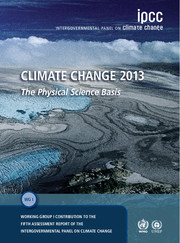 Climate Change 2013 – The Physical Science Basis
Climate Change 2013 – The Physical Science Basis Published online by Cambridge University Press: 05 June 2014
Executive Summary
This chapter assesses long-term projections of climate change for the end of the 21st century and beyond, where the forced signal depends on the scenario and is typically larger than the internal variability of the climate system. Changes are expressed with respect to a baseline period of 1986–2005, unless otherwise stated.
Scenarios, Ensembles and Uncertainties
The Coupled Model Intercomparison Project Phase 5 (CMIP5) presents an unprecedented level of information on which to base projections including new Earth System Models with a more complete representation of forcings, new Representative Concentration Pathways (RCP) scenarios and more output available for analysis. The four RCP scenarios used in CMIP5 lead to a total radiative forcing (RF) at 2100 that spans a wider range than that estimated for the three Special Report on Emission Scenarios (SRES) scenarios (B1, A1B, A2) used in the Fourth Assessment Report (AR4), RCP2.6 being almost 2 W m−2 lower than SRES B1 by 2100. The magnitude of future aerosol forcing decreases more rapidly in RCP scenarios, reaching lower values than in SRES scenarios through the 21st century. Carbon dioxide (CO2) represents about 80 to 90% of the total anthropogenic forcing in all RCP scenarios through the 21st century. The ensemble mean total effective RFs at 2100 for CMIP5 concentration-driven projections are 2.2, 3.8, 4.8 and 7.6 W m−2 for RCP2.6, RCP4.5, RCP6.0 and RCP8.5 respectively, relative to about 1850, and are close to corresponding Integrated Assessment Model (IAM)-based estimates (2.4, 4.0, 5.2 and 8.0 W m−2).
To save this book to your Kindle, first ensure [email protected] is added to your Approved Personal Document E-mail List under your Personal Document Settings on the Manage Your Content and Devices page of your Amazon account. Then enter the ‘name’ part of your Kindle email address below. Find out more about saving to your Kindle.
Note you can select to save to either the @free.kindle.com or @kindle.com variations. ‘@free.kindle.com’ emails are free but can only be saved to your device when it is connected to wi-fi. ‘@kindle.com’ emails can be delivered even when you are not connected to wi-fi, but note that service fees apply.
Find out more about the Kindle Personal Document Service.
To save content items to your account, please confirm that you agree to abide by our usage policies. If this is the first time you use this feature, you will be asked to authorise Cambridge Core to connect with your account. Find out more about saving content to Dropbox.
To save content items to your account, please confirm that you agree to abide by our usage policies. If this is the first time you use this feature, you will be asked to authorise Cambridge Core to connect with your account. Find out more about saving content to Google Drive.